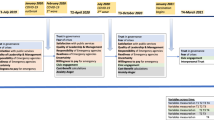Abstract
While numerous works explores how single events or political actions affect public opinion, almost no research explores how this effect evolves with repeated actions. The Conditional Response Model holds that while elite actors can influence and polarize the public when they first act on an issue, subsequent action will not have this same effect. We challenge this model based on its depiction of psychological models of attitude formation and change. Instead of focusing on the number of times an actor has addressed an issue, we argue that the state of public opinion is the key to determining how the public will react to multiple elite actions over a long timeframe. We examine how the public reacted to multiple Supreme Court decisions on abortion. Our results suggest that the Conditional Response Model does a poor job of depicting public opinion and that actors are not limited in their influence by the number of previous actions on an issue.
Similar content being viewed by others
References
Alvarez R. Michael, Brehm John, (1995). American ambivalence toward abortion policy: A heteroskedastic probit method for assessing conflicting valuesAmerican Journal of Political Science 39: 1055–82
Bartels Larry M., (1986). Issue voting under uncertainty: An empirical test American Journal of Political Science 30:709–728
Bianco William, (1998). Different paths to the same result: Rational choice, political psychology and impression formation in campaignsAmerican Journal of Political Science 42: 1061–1081
Clawson, Rosalee A. and Waltenburg, Eric N. (2003). Support for a Supreme Court Affirmative Action Decision: A story in black and white. American Politics Research 31(3): 251–279
Clawson Rosalee A., Kegler Elizabeth, Waltenburg Eric N., (2001). The legitimacy-conferring authority of the U.S. Supreme Court: An experimental design American Politics Research 29(6): 566–591
Cobb Michael, Kuklinski James H., (1997). Changing minds: Political arguments and political persuasionAmerican Journal of Political Science 41: 88–121
Dahl Robert, 1957. Decision making in a democracy: The Supreme Court as a national policy makerJournal of Public Law 6:279–295
Durr Robert H., Martin Andrew D., Wolbrecht Christina, (2000). Ideological divergence and public support for the Supreme CourtAmerican Journal of Political Science 44: 768–777
Feldman Stanley, (1995). Answering survey questions: The measurement and meaning of public opinion. In Lodge Milton, McGraw Kathleen, (Eds). Political Judgment: Structure and ProcessUniversity of Michigan Press Ann Arbor (pp. 249–270)
Franklin Charles H., Kosaki Liane C., (1989). Republican schoolmaster: The U.S. Supreme Court, public opinion, and abortionAmerican Political Science Review 83: 751–771
Gibson James, (1998). A sober second thought: An experiment in persuading Russians to tolerateAmerican Journal of Political Science 42: 819–850
Gilbert Christopher P., (1993). The Impact of Churches on Political Behavior Greenwood Westport CT
Gilens Martin, (2001). Political ignorance and collective policy preferences American Political Science Review 95: 379–396
Grosskopf Anke, Mondak Jeffrey J., (1998). Do attitudes toward specific Supreme Court decisions matter? The impact of Webster and Texas v. Johnson on public confidence in the Supreme CourtPolitical Research Quarterly 51: 63–654
Hibbing John R., Theiss-Morse Elizabeth, (1995). Congress as Public Enemy: Public Attitudes Toward American Political InstitutionsCambridge University Press New York
Hoekstra Valerie J., (1995). The Supreme Court and public opinion change: An experimental study of the Court’s ability to change opinionAmerican Politics Quarterly 23: 109–129
Hoekstra Valerie J., (2003). Public Reaction to Supreme Court Decisions Cambridge University Press New York
Hoekstra Valerie, Segal Jeffrey, (1996). The shepherding of local public opinion: The Supreme Court and Lamb’s ChapelJournal of Politics 58:1079–1102
Huckfeldt Robert, Beck Allen Paul, Dalton Russell J., Levine Jeffrey, Morgan William, (1998). Ambiguity, distorted messages, and nested environmental effects on political communicationJournal of Politics 60: 996–1030
Huddy Leonie, (2002). Crossing the methodological and disciplinary divide: political stability, political change and research method. In Monroe Kristen Renwick, (Eds). Political PsychologyLawrence Erlbaum Hillsdale, NJ
Johnson Timothy R., Martin Andrew D., (1998). The public’s conditional response to Supreme Court decisions American Political Science Review 92: 299–309
Kuklinski, James H. and Hurley, Norman L. (1994). On hearing and interpreting political messages: A cautionary tale of citizen cue-taking. Journal of Politics 56(3): 729–751
Lavine Howard, (2002). On-line versus memory-based process models of political evaluation In Monroe Kristen Renwick, (Eds). Political Psychology. Lawrence Erlbaum Hillsdale, NJ
McGuire William, (1985). Attitudes and attitude change. In Lindzey G., Aronson E., (eds). Handbook of Social PsychologyRandom House New York
Mondak Jeffrey J., (1990). Perceived legitimacy of Supreme Court decisions: Three functions of source credibilityPolitical Behavior 12:363–384
Mondak Jeffrey J., (1993a). Public opinion and heuristic processing of source cues Political Behavior 15: 167–192
Mondak Jeffrey J., (1993b). Source cues and policy approval: The cognitive dynamics of public support for the Reagan agendaAmerican Journal of Political Science 37: 186–212
Mutz Diana, (1998). Impersonal Influence: How Perceptions of Mass Collectives Affect Political AttitudesCambridge University Press New York
Nelson Thomas E., Oxley Zoe M., (1999). Issue framing effects on belief importance and opinion Journal of Politics 61: 1040–1067
Patterson, Thomas C. (1976). Presidential Campaign Impact on Voters: 1976 Panel Erie, Pennsylvania and Los Angeles. ICPSR Study Number 7990
Patterson Thomas C., (1980). The Mass Media ElectionPraeger New York
Petty Richard, Cacioppo John T., (1986a). Communication and Persuasion: Central and Peripheral Routes to Attitude Chang. Springer Series in Social Psychology Springer-Verlag New York
Petty Richard, Cacioppo John T., (1986b). The elaboration likelihood model of persuasion. In Berkowitz L., (Eds). Advances in Experimental Social Psychology Academic Press San Diego, CA
Petty Richard E., Wegener Duane T., Fabrigar Leandre, (1997). Attitudes and attitude changeAnnual Review of Psychology 48:609–647
Zaller John R., (1992). The Nature and Origins of Mass OpinionCambridge University Press New York
Zaller John R., Feldman Stanley, (1992). A simple theory of survey response: Answering questions versus revealing preferencesAmerican Journal of Political Science 36:579–616
Acknowledgments
We would like to thank Jan Leighley for detailed comments, Chris Owens for research assistance, and ICPSR for making the data available.
Author information
Authors and Affiliations
Corresponding author
Rights and permissions
About this article
Cite this article
Brickman, D., Peterson, D.A.M. PUBLIC OPINION REACTION TO REPEATED EVENTS: Citizen Response to Multiple Supreme Court Abortion Decisions. Polit Behav 28, 87–112 (2006). https://doi.org/10.1007/s11109-005-9003-0
Published:
Issue Date:
DOI: https://doi.org/10.1007/s11109-005-9003-0




